
An auxiliary ship is a naval ship designed to support combatant ships and other naval operations. Auxiliary ships are not primary combatant vessels, though they may have some limited combat capacity, usually for purposes of self-defense.
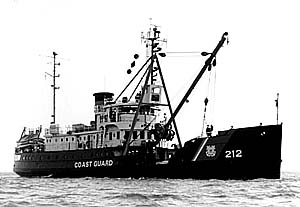
Moore Dry Dock Company was a ship repair and shipbuilding company in Oakland, California. In 1905, Robert S. Moore, his brother Joseph A. Moore, and John Thomas Scott purchased the National Iron Works located in the Hunter's Point section of San Francisco, and founded a new company, the Moore & Scott Iron Works Moore had previously been vice president of the Risdon Iron Works of San Francisco. Scott was nephew to Henry T. and Irving M. Scott, owners of the nearby Union Iron Works, where John had risen from apprentice to superintendent. Their new business was soon destroyed by fire resulting from the San Francisco earthquake.
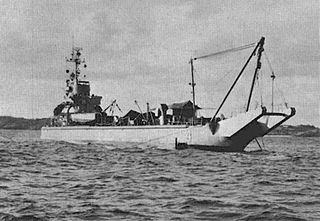
USS Windlass, a Gypsy-class salvage lifting vessel of the United States Navy, was originally conceived as LSM-552 and laid down on 27 August 1945 at Houston, Texas, by Brown Shipbuilding Corporation. Launched on 7 December 1945; and commissioned on 9 April 1946 in Houston at the Tennessee Coal and Iron Docks.

The Type B ship is a United States Maritime Administration (MARAD) designation for World War II barges. Barges are very low cost to build, operate and move. Barges were needed to move large bulky cargo. A tug boat, some classed as Type V ships, could move a barge, then depart and move on to the next task. That meant the barge did not have to be rushed to be unloaded or loaded. Toward the end of World War 2, some ships that had not been completed in time for the war were converted to barges. US Navy barges are given the prefix: YWN or YW. Due to shortage of steel during World War II, concrete ship constructors were given contracts to build concrete barges, with ferrocement and given the prefix YO, YOG, YOGN. Built in 1944 and 1945, some were named after elements.

The Type V ship is a United States Maritime Commission (MARCOM) designation for World War II tugboats. Type V was used in World War II, Korean War, and the Vietnam War. Type V ships were used to move ships and barges. Type V tugboats were made of either steel or wood hulls. There were four types of tugboats ordered for World War II. The largest type V design was the sea worthy 186-foot (57 m) long steel hull, V4-M-A1. The V4-M-A1 design was used by a number of manufacturers; a total of 49 were built. A smaller steel hull tugboat was the 94-foot (29 m) V2-ME-A1; 26 were built. The largest wooden hull was the 148-foot (45 m) V3-S-AH2, of which 14 were built. The smaller wooden hull was the 58-foot (18 m) V2-M-AL1, which 35 were built. Most V2-M-AL1 tugboats were sent to the United Kingdom for the war efforts under the lend-lease act. The Type V tugs served across the globe during World War II including: Pacific War, European theatre, and in the United States. SS Farallon, and other Type V tugs, were used to help built Normandy ports, including Mulberry harbour, on D-Day, 6 June 1944, and made nine round trips to Normandy to deliver Phoenix breakwaters.

An auxiliary floating drydock is a type of US Navy floating dry dock. Floating dry docks are able to submerge underwater and to be placed under a ship in need of repair below the water line. Water is then pumped out of the floating dry dock, raising the ship out of the water. The ship becomes blocked on the deck of the floating dry dock for repair. Most floating dry docks have no engine and are towed by tugboats to their destinations. Floating dry docks come in different sizes to accommodate varying ship sizes, while large floating dry docks come in sections and can be combined to increase their size and lift power. Ballast pontoon tanks are flooded with water to submerge or pumped dry to raise the ship.

USS AFDM-2,, is an AFDM-3-class medium auxiliary floating drydock built in Mobile, Alabama by the Alabama Drydock and Shipbuilding Company for the U.S. Navy. Originally named USS YFD-4, Yard Floating Dock-4, she operated by Todd Shipyards at New Orleans, Louisiana for the repair of US ships during World War II. YFD-4 was renamed an Auxiliary Floating Dock Medium AFDM-2 in 1945 after the war.
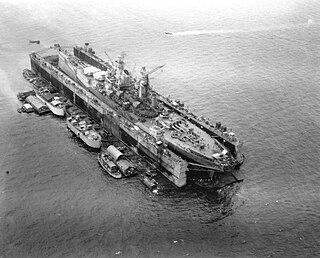
USS ABSD-2, later redesignated as AFDB-2, was a ten-section, non-self-propelled, large auxiliary floating drydock of the US Navy. Advance Base Sectional Dock-2 was constructed in sections during 1942 and 1943 by the Mare Island Naval Shipyard in Vallejo, California for World War II. Her official commissioning ceremony took place on 14 August 1943 with CDR. Joseph J. Rochefort in command. With all ten sections joined, she was 927 feet long, 28 feet tall, and with an inside clear width of 133 feet 7 inches. ABSD-2 had a traveling 15-ton capacity crane with an 85-foot radius and two or more support barges. The two side walls were folded down under tow to reduce wind resistance and lower the center of gravity. ABSD-2 had 6 capstans for pulling, each rated at 24,000 lbf (110,000 N) at 30 ft/min (0.15 m/s), 4 of the capstans were reversible. There were also 4 ballast compartments in each section.

USS ABSD-4, later redesignated as AFDB-4, was a nine-section, non-self-propelled, large auxiliary floating drydock of the US Navy. Advance Base Sectional Dock-4 was constructed in sections during 1942 and 1943 by the Mare Island Naval Shipyard in Vallejo, California for World War II. With all ten sections joined, she was 927 feet long, 28 feet tall, and with an inside clear width of 133 feet 7 inches. ABSD-4 had a traveling 15-ton capacity crane with an 85-foot radius and two or more support barges. The two side walls were folded down under tow to reduce wind resistance and lower the center of gravity. ABSD-4 had 6 capstans for pulling, each rated at 24,000 lbf (110,000 N) at 30 ft/min (0.15 m/s), 4 of the capstans were reversible. There were also 4 ballast compartments in each section.
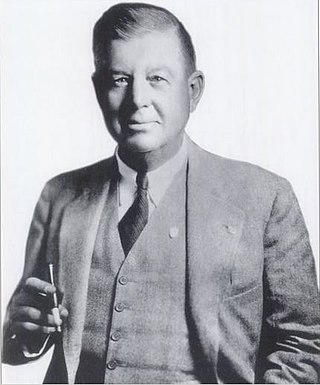
Pacific Bridge Company was a large engineering and construction company. During World War II, Pacific Bridge Company of Alameda, California was selected to build US Navy Auxiliary Repair Docks (ARD) a type of Auxiliary floating drydock and Type B ship barges.
Everett-Pacific Shipbuilding & Dry Dock Company was established in 1942 to build ships needed for World War II. Yard construction began on 1 March 1942. As part of the Emergency Shipbuilding Program the US Navy provided some of the capital to start Everett-Pacific Shipbuilding at Port Gardner Bay in Everett, Washington. Everett-Pacific was sold in 1945 to the Pacific Car and Foundry, who was already a major manufacturer of railcars and trucks. Pacific Car and Foundry was building barges for the US Navy during World War II at plants in Renton, Seattle and Tacoma in the state of Washington. The lease for the shipyard in Everett, Washington ended in 1949 and the yard closed. Pacific Car and Foundry in 1972 changed its name to Paccar Inc. to reflect its major products. The Everett-Pacific shipyard site later became part of Western Gear, a heavy machinery manufacturer. in 1987 the shipyard became part of Naval Station Everett. Everett-Pacific Shipbuilding was started by William Pigott Jr. a Seattle businessmen and his brother Paul Pigott (1900-1961). William Pigott Jr. was born in 26 Aug. 1895 in Pueblo, CO and died on 8 July 1947 in San Francisco, CA.
Pollock-Stockton Shipbuilding Company was established in 1942 to build ships needed for World War II. As part of the Emergency Shipbuilding Program the US Navy provided some of the capital to start Pollock-Stockton Shipbuilding at Stockton, California. The shipyard was located at San Joaquin River and Stockton Channel, near Louis Park. After the war the shipyard closed down in February 1946.

Walter Butler Shipbuilders Inc. was a large-scale World War II ship manufacturing shipyard, located at Superior, Wisconsin. Walter Butler purchased the shipyard from Lake Superior Shipbuilding in 1942. Walter Butler Shipbuilders Inc. was at E 1st St, Superior, Wisconsin. The shipyard was located on the western part of Lake Superior. Walter Butler Shipbuilders Inc. was found by Walter Butler in 1942 to built ships for World War II. Walter Butler Shipbuilders Inc., the McDougall Duluth Shipbuilding Company and the Superior Shipbuilding Company were called the Twin Ports shipbuilding industry of Minnesota and Wisconsin. Once built the ships can travel to the Atlantic Ocean through the Great Lakes and the Saint Lawrence Seaway.
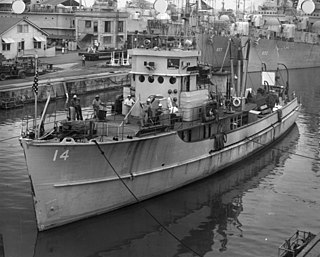
South Coast Shipyard was a shipbuilding company in Newport, California. To support the World War II demand for ships South Coast Shipyard built: minesweepers, Torpedo Boats, Submarine chasers, & Air-sea rescue boats. South Coast Shipyard was opened in 1938 by Walton Hubbard. After World War II the shipyard continued to build ships for the US Navy till 1955. The shipyard was located at 2300 Newport Boulevard, Newport, California. The shipyard closed in 1963.

W. F. Stone & Son or Stone Boat Yard was a small wooden shipbuilding company in Alameda, California. To support the World War 2 demand for ships W. F. Stone & Son built tugboats, sub chasers and minesweepers. For World War 1 the shipyard, then called W. F. Stone & Son at Kennedy and Bocimer Streets, built tugboats for postwar work in 1921. The shipyard was opened in 1853 by William F. Stone, from Dartmouth, England, at the Hunter's Point in San Francisco Bay, near the current Hunters Point Naval Shipyard. In 1892 William Stone's son, Frank, ran the company and moved the shipyard to Tiburon. In 1899 he moved the shipyard again to Harbor View, San Francisco. In 1911, he again moved to Diesel Way, in Oakland, near Union Point Park on the Tidal Canal. When Lester Stone, Frank's son, became a partner, the company was changed to W. F. Stone & Son. In 1923, Frank Stone died, Lester Stone continued the company. In 1942 the company moved again, to 2517 Blanding Ave, Alameda on the south side of the Tidal Canal. In 1970 Lester Stone retired and sold the shipyard to John Whitset. Whitset, who did not rename the company, the company went into bankruptcy in 1986. It came out of bankruptcy and was sold to Bill and Grace Bodle. Bodle sold the company in 2000 to David Olson. The shipyard closed in 2004. For most of its history, the shipyard built a large variety of schooners, fishing boats, cargo ships, tugboats, sailboats, racing and recreational yachts.

Anderson & Cristofani was a wooden shipbuilding company in San Francisco, California. To support the World War 2 demand for ships Anderson & Cristofani shipyard switched over to military construction and built: US Navy APC coastal transports, tugboats, Patrol Boats and Minesweepers.

The Pacific Coast Engineering Company or PACECO is an American industrial fabricator and mechanical engineering company, and was previously a shipbuilding company in Oakland, California and then Alameda, California. To support the World War II demand for ships, PACECO shipyard switched over to military construction and built US Navy Tugboats.

Moore Equipment Company was founded in 1929 by Stanley S. Moore and his father in Stockton, California. Moore Equipment Company a repair and manufacture company of farm machines, road machines and tools. To support the World War 2 demand for ships Moore Equipment Company built a shipyard and switched over to military construction and built: US Navy YSD-11 Class Seaplane Wrecking Derricks, landing craft and barges. Moore Equipment Company also did work for the US Army repairing and rebuilding jeeps by way of the Ford Motor in Richmond. The shipyard also did Navy ship repair. Moore Equipment Company's main work before the war was on tractors, cranes, trucks, bulldozers, power winches, road scrapers and tools. The Moore Equipment Company office was at 1250 South Wilson Way, Stockton, now the Fairgrounds Industrial Park. Equipment Company sold the factory on February 15, 1944 to International Harvester Company. The shipyard closed after the war.</ref>

Splinter fleet or Splinter navy was a nickname given to the United States wooden boats used in World War II. The boats served in many different roles during the war. These boats were built in small boatyards on the West coast and East coast, Great Lakes and the Gulf of Mexico. They could be built quickly, in just 60 to 120 days. Most of the boats were built by boatyards that already had the tools and knowledge from building yachts, sailboats and motor boats. Many were built by craftsmen in family-owned small businesses. Under the Emergency Shipbuilding Program and War Shipping Administration contracts went out to over fifty boatyards across the country. The boats were built for the US Navy, the United States Army Air Forces, United States Coast Guard, and US Army. Some of the wooden boats went to Allied nations on the Lend-Lease program.

Soule Steel Company was a manufacturer of fabricated steel building products. The main office was in San Francisco, California with branch offices in Los Angeles, California, Portland, Oregon and Seattle, Washington. Soule Steel worked on major construction projects like: the reinforcing steel on the footings for the Golden Gate Bridge, California Memorial Stadium at University of California, Berkeley, San Francisco high rises buildings, Los Angeles Memorial Coliseum, Vincent Thomas Bridge, Space Needle and the Grand Coulee Dam. For World War II Soule Steel built landing crafts and floating derricks for seaplane moving, a class YSD-11 Class Seaplane Wrecking Derrick in the Terminal Island shipyard. Soule Steel also built steel barges for the war. After the war the shipyard built some tuna fishing ships. Soule Steel was started by Edward Soulé in 1911. Edward Soulé was a civil engineer in San Francisco and saw the damage done by the 1906 San Francisco earthquake. So, in 1911 started a steel rebar business, called Edw. L Soulé Campany to help make new buildings stronger. The company name was changed in 1927 to Soule Steel Company. The family-owned business grew and at its peak had nine 9 fabrication shops, a steel mill, a division for building steel buildings, and a steel window and doors division. Edw. L Soulé retired in 1945 and Stanley Soul continued the company, and later Edward Lee Soule Jr. (1917-2003) and his brothers: Howard Stephen Soule (1924-2010), Lee Soule and Peter Soule. Soule Steel and Zamil Steel founded a joint venture in 1930. Soule family was also a family of philanthropy and gave to many charities. Soule Steel closed in 1986. The San Francisco plant and Portland plant are now business centers. The Wilmington Ave Los Angeles plant is now The Plaza Americana. The Seattle plant is now Ferguson Plumbing warehouse. The Phoenix site is now a food court. San Jose site is a vacant lot. Fresno site is now apartments.





















